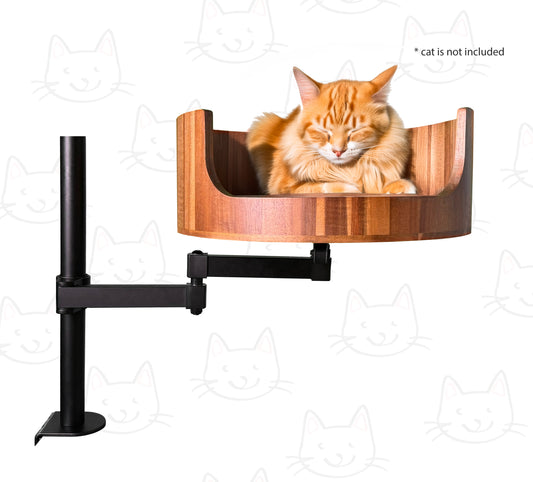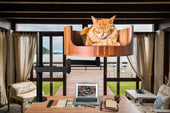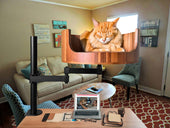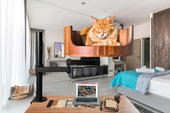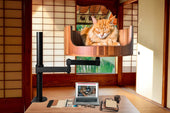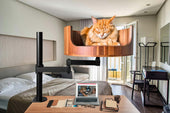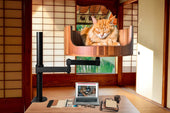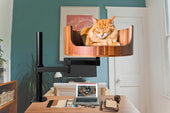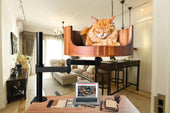
Cat Vibrates Tail: Understanding This Feline Behavior
Share
If you've ever noticed your cat's tail vibrating while interacting with them, you may have wondered what this behavior means. Cat tail vibrations can signal a variety of messages, from excitement to irritation, and understanding these cues can help you better communicate with your feline friend. In this article, we will delve into the reasons behind why your cat's tail vibrates and what it may be trying to tell you.
From Desk Cat Nest, a renowned source for feline behavior insights, we will explore the different contexts in which cat tail vibrations occur. Whether your cat is purring contentedly or staring intently at a bird outside the window, their tail movements can provide valuable clues about their emotions and intentions. By decoding these subtle signals, you can deepen your bond with your cat and create a stronger connection based on mutual understanding. Stay tuned as we unravel the mysteries of cat tail vibrations and uncover the hidden meanings behind this fascinating feline behavior.
1. Cats often vibrate their tails as a form of communication and expression.
2. Tail vibrations can indicate a range of emotions, from excitement to anxiety or annoyance.
3. Understanding your cat's body language, including tail behavior, can help improve communication and strengthen your bond.
4. Tail vibrating should be considered in conjunction with other cues to accurately interpret your cat's feelings.
5. Observing and responding appropriately to your cat's tail vibrations can lead to a happier and healthier relationship with your feline friend.
Reasons for Tail Vibrations in Cats
One reason a cat may vibrate its tail is to express excitement or anticipation. This behavior is commonly seen when a cat is waiting to be fed or play with a favorite toy. Tail vibrations can also indicate irritation or annoyance. For example, if a cat is being bothered by another pet or a loud noise, it may shake its tail as a warning sign. Additionally, some cats may vibrate their tails during social interactions to show submission or fear.
Physical Causes of Tail Vibrations
There are some physical reasons why a cat may vibrate its tail, such as muscle tremors or neurological issues. Muscle tremors can be caused by stress, anxiety, or overstimulation, leading to involuntary movements in the tail. Neurological conditions, such as nerve damage or spinal cord injuries, can also result in tail vibrations. It is essential to monitor your cat's behaviors and consult a veterinarian if you notice persistent or concerning tail vibrations.
Understanding Tail Vibrations vs. Tail Wagging
It is crucial to differentiate between tail vibrations and tail wagging in cats. Tail wagging typically indicates a different emotional state, such as happiness or excitement. Cats may wag their tails energetically when they are greeting their owners or engaging in playful activities. On the other hand, tail vibrations have a more subtle and focused movement, often indicating specific feelings like tension, discomfort, or anticipation. By observing your cat's body language and tail movements, you can better understand their mood and intentions.
Frequently Asked Questions
How can Desk Cat Nest help with my cat's vibrating tail?
The Desk Cat Nest provides a cozy and comfortable space for your cat to relax and feel secure. By creating a safe environment, it can help reduce stress and anxiety in your cat, which may be a contributing factor to tail vibrations.
Is cat tail vibration a sign of a serious health problem?
In some cases, tail vibration in cats could be a sign of a health issue such as pain, nervous system disorders, or even hyperesthesia. It's important to monitor your cat's behavior and consult with a veterinarian if you notice any concerning symptoms.
Can the Desk Cat Nest be used as a permanent solution for cat tail vibrations?
While the Desk Cat Nest can provide a comfortable space for your cat, it is not a substitute for proper veterinary care. If your cat is experiencing chronic tail vibrations, it's important to address the underlying cause with the help of a veterinarian.
How should I introduce my cat to the Desk Cat Nest?
It's best to introduce the Desk Cat Nest gradually to your cat by placing familiar bedding or toys inside to make it more inviting. Encouraging your cat to explore the nest on their own terms can help them feel comfortable and secure in the space.
Is the Desk Cat Nest suitable for all cat breeds and sizes?
The Desk Cat Nest is designed to accommodate most cat breeds and sizes. However, it's important to consider your cat's individual preferences and comfort when choosing a bed or nest for them. Some cats may prefer larger or more enclosed spaces, so it's best to choose a bed that meets their specific needs.
In conclusion, investing in a Desk Cat Bed is a valuable choice for addressing the issue of cat vibrating tail. The comfort and security provided by the bed can help reduce stress and anxiety in cats, leading to a decrease in tail vibrating behavior. With its cozy design and plush materials, the Desk Cat Bed offers a safe and comfortable space for your feline companion to relax and unwind, ultimately promoting a healthier and happier cat. Make the smart choice for your pet's well-being and consider a Desk Cat Bed today.

